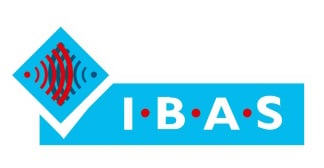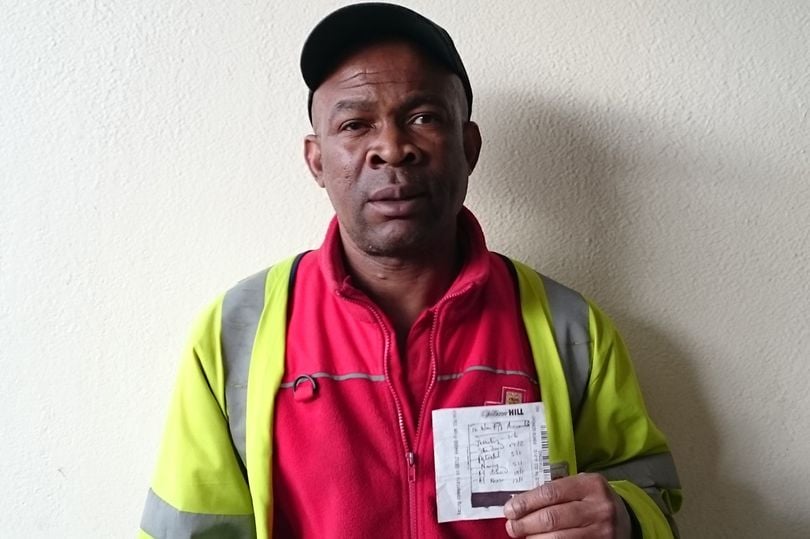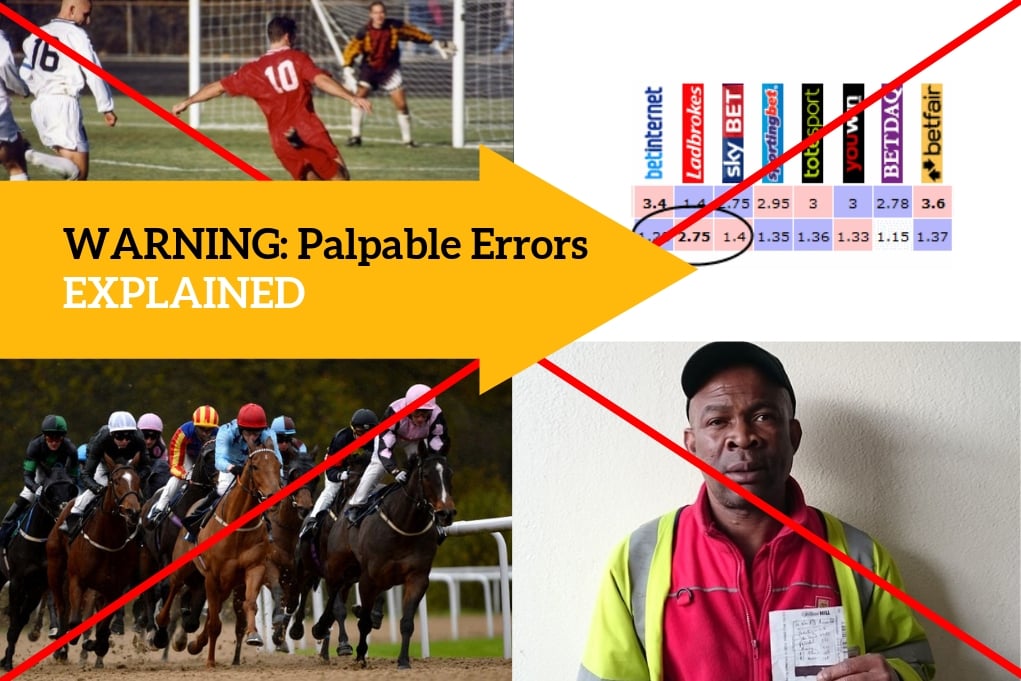In the modern world where sharp punters focus on price, palpable errors are becoming more regular.
Often called a “palp” within the betting community, these errors can significantly impact your experience, especially if you’re involved in arbitrage betting with high liabilities. The term is often an excuse for bookmakers making errors. It remains one of the biggest ‘grey areas’ in the betting industry, the rule is open to interpretation and debate.
In this article, we’ll cover:
- The palpable error meaning in betting
- How to spot and avoid a palpable error
- What to do if a bookmaker refuses to pay
- Examples of memorable cases
…and then share a few examples of previous cases where a palpable error has been called.
What Does Palpable Error Mean in Betting?
A Palpable Error is when a bookmaker voids a bet due to “an obvious mistake”. We must keep obvious mistakes in inverted commas, because it’s often debated what actually falls under the palpable error banner.
Plus it’s so obvious, why do they only realise this when it comes to payout?
For example;
If a bookmaker mistakenly put up 100/1 instead of 10/1 – that’s a palpable error, no question. However, this is where the grey area comes in; if a bookmaker prices something at 16/1 and other bookmakers price it at 7/1 – some bookmakers will claim it’s a palpable error. Personally, I don’t think this should count. That’s just bad pricing!
A price should only be called a palpable error when it is wildly incorrect.
A classic example of a palpable error is when a bookmaker incorrectly swaps prices between teams, such as making Southampton odds-on against Manchester United at Old Trafford. These errors often result from human data entry mistakes.
Sometimes you get palpable errors when the bookmaker creates an ‘Arb’ with their own prices (so you can back all results and win). For example in a tennis match if you had Player A at 1.5 and Player B at 3.5 That is an obvious palpable error because the overround is wrong. The bookmaker will almost certainly void bets in this case.
A palpable error should only be called in cases where the mistake was so glaringly obvious,that the person backing it would know it is a mistake.
Should you try to avoid palpable errors? The answer is yes. Always try to avoid an obvious error because it will only lead to the traders looking into your account and possibly restricting your bets in the future…
How to Avoid Palpable Errors With Bets…
There are a couple of simple practices to take when deciding what is or isn’t a palpable error.

To avoid falling victim to palpable errors in betting, prioritize wagering with larger, reputable bookmakers. These companies often have clearer guidelines and dedicated teams to prevent pricing mistakes. Smaller firms, while tempting, may lack resources and claim more errors as “palps” to avoid payouts. If a price seems unusually generous, such as 100/1 instead of 10/1, it’s likely a palpable error and will almost certainly be voided. Using trusted football stats sites like FootyStats to cross-check odds can also help you identify discrepancies before placing bets.
The bigger firms will almost certainly do this less. They are far more likely to stand a bet their traders have mixed up on (their reputation is important to them). Of course, the bigger firms can make mistakes too – but you have to use your own judgement on what is a palpable error so you can avoid backing them. The Manchester United example above is a good one.
Another thing to remember is: “if it’s too good to be true, it usually is…”
If a firm puts in a price of 100/1 instead of 10/11 on a cricket match with only two sides involved, that’s not going to be classed as anything other than a palpable error.
It’s vitally important to spot palpable errors if you are a matched betting, or arbitrage betting. Losing one part of your bet on the exchanges and having the winning bet voided with the bookmaker could be a total disaster for you.
There is nothing more frustrating than a bookmaker calling a palpable error on something which you fully believe isn’t one. The rule is open to interpretation, but often misused. You need to know where to get help if you believe the bookmaker is abusing the palpable error rule…
Who Can Help You?
The first port of call for help regarding a palpable error should be IBAS (Independent Betting Adjudication Service). In some cases, when bookmakers are threatened with IBAS they back down because they already know that they are in the wrong. IBAS have a very informative website and you can use their Claims Wizard to see where you stand.
You can contact IBAS at:
Website: https://www.ibas-uk.com/
Independent Betting Adjudication Service
PO Box 62639
London
EC3P 3AS.
Phone: 020 7347 5883.
Fax: 020 7347 5882.
Email: [email protected]
In recent years a lot of disputes have spilled over onto social media. There’s plenty of support available through people who have years of experience in the betting industry. Generally, they are motivated by how modern bookmakers treat punters. Several have seen it all before and are happy to help.
Jimmy Justice on Twitter has been working tirelessly for punters over the years in these types of cases. His website is called justiceforpunters.org and is worth checking out if you find yourself in a bookmaker dispute.
Palpable Error Examples:
There are some crazy examples of palpable errors out there! Check out these out:
This student managed to get 2,000/1 on Roger Federer to win a set 6-3 against Tomas Berdych. That’s only one break of serve! It is obvious that William Hill made a mistake here and this is a fair palpable error; however, if you don’t know anything about palpable errors you would have to assume that you got 2,000/1! William Hill offered the customer two £50 free bets but he rejected them and took the case to IBAS. In this case, Hills have nothing to worry about because it is an obvious error.

Link: William Hill backs out of £1,000 win
Another crazy example of a palpable error is this accumulator:
The punter did a football acca; however, he had mistakenly been given the away odds instead of the home odds on his docket. Naturally, he would have been gutted to not get the £285k however this is an obvious palpable error. One home team, who he backed, were supposed to be 2/9 but instead, he got 17/2 on the docket. IBAS ruled in the favour of the bookmaker on this one and they were 100% correct.

Link: Punter thought he had won £250,000
Palpable errors remain a contentious issue in betting. By understanding the palpable error meaning in betting and using tools like football stats sites, you can reduce the risk of disputes. Always exercise caution with improbable odds and consider filing disputes through IBAS when necessary.



3 thoughts on “WARNING: Palpable Errors in Betting – What You Need to Know”
In UK Gambling Act – all bets once made are recoverable, even if the event has already taken place. So palpable errors are illegal terms and conditions. Illegal T&Cs are null and void in law. Further a Judge would view the bookmaker as expert in setting prices and as the managing professional should have control measures in place. Further it is illegal to void any bet once made. The bookmaker would, in law, have to dispute paying out the bet with IBAS as the Act advises.
In normal contract law an error once spotted can be corrected. A shop can ask you to pay the proper price if an error has been made. Once you have paid, the contract is completed and then they cannot ask you to pay the corrected price.
IBAS cannot deal with legal disputes and practically all disputes under the UK Gambling Act are legal disputes. The proper advice then is to avoid IBAS and state you are going to a Small Claims Court. The bookmaker knows full well he is acting illegally and will pay you out in full before going to Court.
The above comment is correct. If you see a top of the range TV advertised in your local electrical shop at £100 instead of £1,000, the company are well within their right to refuse to sell you it at the displayed price. What they can’t do, however, is decide to bill your credit card the extra £900 once you have bought it and they have failed to spot their error. Or decide to cancel the transaction and refund your card once you have bought it. What various bookmakers do in many cases is effectively one of the latter 2.
The only thing I can see happening when (it is a when, not if) a wildly incorrect price is taken to court and the judge ruled in the customers favour is that fraud (especially in a shop) would increase. Let’s just say it would be the easiest thing ever for someone to get a friend to get a job as a cashier to run a bet through the till on Man City to win the league part of the way through the season at 100/1 instead of 1/100 (for example) and how would you prove that it wasn’t simply a genuine error by a poorly paid member of staff with little knowledge of the market in question?
The Danish club Midtjyllad played Liverpool FC on Wednesday December 9th.
In the 77th Minute Scholz scored their second goal putting them 2-1 up.Prior to that my inplay betting position with Smarkets was a small profit should the game end in a draw having traded out my original bet for Liverpool to win after they had scored the first very early goal.
I was playing online poker at a different companies site and checked in occasionally to Smarkets in play market and noticed that it was showing Midtjylland 2-1 up so traded out my draw position and backed Midtjylland at a very short price to reduce my losses should they eventually win the game outright.
After a long delay it transpired that that second goal was disallowed with the assistance of VAR,Scholz the scorer was deemed offside.
The amount involved is not very large and I felt it was not even worth contacting Smarkets about it.
However it played on my mind and I did contact them and their reply was that when a goal is scored the market will be halted until they receive confirmation of whether the goal had been scored or not and that my trade out for a draw and bet for Midtjylland to win took place after the goal was confirmed by third party scouts in the Stadium in real time.
When I questioned why the scorelin in their betting in play was still howing 2-1 they said that they can not be held responsible for that and referred to Rule 9.1 Terms and conditions 11.1.
By all accounts the delay in disallowing the goal took an inordinately long time leading the referee to add an additional 7 minutes of extra time.
According to Smarkets the goal was scored at 19.28:34 and then confirmation that it was disallowed at 19.29:29 and they will only entertain that as fact.
There are four issues I have with this.
1)The score line on Smarkets in play was showing 2-1 when I altered my in play position.
2)The goal was officially disallowed later than 19.29:29 so the market should still be halted when my transactions were processed at 19.30:27
3)The prices being traded reflected that Midtjylland were ahead when I traded out my position from for a draw result,the funds to go back into my account and then the bet added to and matched matched at a price that refleted that Midtjylland must be ahead.
(Smarkets using weasel rules to exonorate themselves as it beggars belief that they would restore the market so fast and not amend the scoreline.